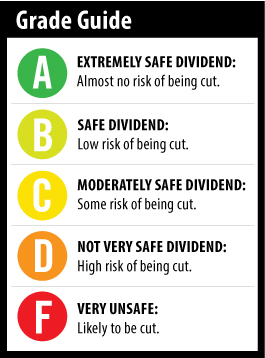 I became an investor at a very early age… about a week old.
I became an investor at a very early age… about a week old.
That’s when my grandfather bought me five shares of AT&T (NYSE: T). I wish I had reinvested the dividends and held on to the stock rather than having sold it about 20 years ago.
Several Wealthy Retirement readers – including Dewey and Gary – asked me to take a look at Ma Bell’s dividend safety this week. I can tell you right off the bat that I like the stock.
So much so that I recommended it to Oxford Income Letter subscribers in February. Subscribers who bought the stock when it was recommended are already up 13.2%.
[ad#Google Adsense 336×280-IA]AT&T, with its 5.2% yield, is the highest yielding component of the Dow Jones Industrials, qualifying it to be a Dog of the Dow – the strategy where each year the investor buys the top 10 yielding stocks of the Dow Jones Industrials.
Along with being a Dog of the Dow, AT&T is also a Dividend Aristocrat (a much more complimentary moniker).
Aristocrats are stocks that are members of the S&P 500 that have raised their dividends every year for at least 25 years.
AT&T has raised its dividend for each of the past 30 years. That was when its monopoly was broken up and it divested itself of the local phone companies that it owned. The annual increase has been by a penny per share since 2008.
Dialing for Dollars
AT&T is the 20th-largest publicly traded company on U.S. exchanges. So it’s no surprise that it makes billions of dollars per quarter in profit.
But as you know if you’ve read this column for a while, I am more interested in cash flow. That’s what pays investors dividends. Cash flow is essentially net income including all of the non-cash items like depreciation and amortization.
Over the past 12 months, AT&T has generated $13 billion in free cash flow. During that period, it paid out $9.6 billion in dividends. That’s a payout ratio of 73.8%. The payout ratio is the percentage of earnings or free cash flow that is paid out in dividends.
Typically, I like to see a company pay out 75% or less of its cash flow in dividends, so AT&T is just shy of that boundary.
The payout ratio was 71.3% last year.
This year, Wall Street predicts AT&T will create $11.8 billion in free cash flow. If the company pays out the similar $9.6 billion in dividends that it has over the past 12 months, the payout ratio will be 81.3%, which is above my comfort zone.
Next year, the payout ratio could be back below 75% as free cash flow is projected to be $13.6 billion in 2015 and up to $14.9 billion in 2016.
 AT&T is in a very competitive business. It is the largest telecom company in the world with 110 million wireless subscribers.
AT&T is in a very competitive business. It is the largest telecom company in the world with 110 million wireless subscribers.
It has voice coverage in 225 countries and data roaming services in 210 countries.
Customers can use more than 1 million Wi-Fi hot spots around the world.
The company, which can trace its roots all the way back to Alexander Graham Bell in 1876, is a mainstay of corporate America.
It has reliably paid shareholders an increasing dividend for decades, including during the Great Recession.
With enough cash flow to cover the dividend, I don’t see any reason why that should change in the coming years.
Dividend Safety Rating: A
— Marc Lichtenfeld
[ad#IPM-article]
Source: Wealthy Retirement
